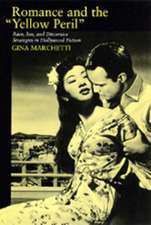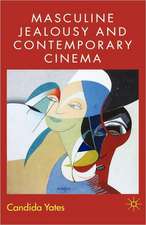The Palgrave Handbook of Asian Cinema
Editat de Aaron Han Joon Magnan-Park, Gina Marchetti, See Kam Tanen Limba Engleză Paperback – 27 noi 2019
| Toate formatele și edițiile | Preț | Express |
|---|---|---|
| Paperback (1) | 1674.52 lei 6-8 săpt. | |
| Palgrave Macmillan UK – 27 noi 2019 | 1674.52 lei 6-8 săpt. | |
| Hardback (1) | 1683.29 lei 6-8 săpt. | |
| Palgrave Macmillan UK – 14 noi 2018 | 1683.29 lei 6-8 săpt. |
Preț: 1674.52 lei
Preț vechi: 2042.09 lei
-18% Nou
Puncte Express: 2512
Preț estimativ în valută:
320.40€ • 334.57$ • 264.59£
320.40€ • 334.57$ • 264.59£
Carte tipărită la comandă
Livrare economică 15-29 aprilie
Preluare comenzi: 021 569.72.76
Specificații
ISBN-13: 9781349959808
ISBN-10: 1349959804
Dimensiuni: 155 x 235 mm
Greutate: 1.05 kg
Ediția:1st ed. 2018
Editura: Palgrave Macmillan UK
Colecția Palgrave Macmillan
Locul publicării:London, United Kingdom
ISBN-10: 1349959804
Dimensiuni: 155 x 235 mm
Greutate: 1.05 kg
Ediția:1st ed. 2018
Editura: Palgrave Macmillan UK
Colecția Palgrave Macmillan
Locul publicării:London, United Kingdom
Cuprins
1.
Introduction: “Asia”
and
Asian
Cinema, Aaron
Han
Joon
Magnan-Park,
Gina
Marchetti,
and
Tan
See-Kam.-
Section
I: Defining
Asian
Cinema
in
the
21st
Century.-
2.
The
Desire
for
a
Continental
Poly-Asian
Cinema
Movement, Aaron
Han
Joon
Magnan-Park.-
3.
Cinema
and
Development:
Towards
an
Ideological
History
of
Asian
Cinema
as
“World
Cinema”,
Derek
Lam.-
4. Theorizing
Other
Asian
Cinemas:
The
Sensorium
of
Transcaucasia, Anne
Ciecko.-
5.
East
Asia’s
Film
Business,
Ruby
Cheung.-
6.
Alibaba
Goes
to
the
Movies, Mark
Gallagher.-
7. New
Media/New
Asia:
Dominant
and
Residual
Geographies
of
Emerging
Media
Arts, Stephanie
DeBoer.-
Section
II: Locating
the
New
Asian
Cinema:
Changing
Aesthetics,
Distribution
Networks,
and
Global
Connections.-
8.
Locating
Turkish
Cinema:
Traditional
Eastern
Aesthetics
to
Western
Modernity, Murat
Akser.-
9.
The
Asian
Documentary
Connections:
From
the
Yamagata
International
Documentary
Film
Festival
(YIDFF)
to
the
Asian
Network
of
Documentary
(AND),
Ma
Ran.-
10. Small
Asias
Outside
of
Asia—Asian
Film
Festivals
in
Europe, Eija
Niskanen.-
11.
Distributing
and
Marketing
Asian
Cinema:
Definitions
from
DVD
Labels,
Jonathan
Wroot.-
12.
Contemporary
Japanese
Viewership:
Revisiting
the
Cinema,
Jennifer
Coates.-
Section
III:
Asian
History
in
the
Making.-
13.
Peace
Before
the
Storm:
Japanese
Cinematographers
and
Their
Asian
Imagination
in
the
1920s-30s,
Daisuke
Miyao.-
14.
Reframing
Loss:
Japanese
Cinematic
Melancholia
in
Inter-Asian
Contexts
, Earl
Jackson,
Jr..-
15.
Mao
and
Gandhi
in
the
Fight
Against
Corruption:
Popular
Film
and
Social
Change
in
China
and
India, Krista
Van
Fleit
Hang.-
16.
Colonial
Censorship
and
the
Cultural
Politics
of
Chinese-language
Cinemas
in
the
Cold
War, Kenny
K.
K.
Ng.-
17.
The
Long
Roads
to
Global
Hollywood:
Shaw
Brothers,
Golden
Harvest
and
Dalian
Wanda, Tan
See-Kam.-
Section
IV:
Remaking
Asia
and
the
Asian
Diaspora—New
Tales
of
an
(Un)
Common
Past.-
18.
Martial
Arts
Fantasies
in
a
Globalized
Age:Kung
Fu
HustleandKung
Fu
Panda, Jing
Yang.-
19.Taipei
and
Tokyo:
Turf
Wars
Over
Identity,
Yun
Xia.-
20. Aspirationally
Yours:
Pan-Asian
Cinematic
Convergence,
Staci
Ford.-
21.
Transnational
Asian
Cinema
through
the
Lens
of
Cinephiles
and
Transmedia
Fans, Wikanda
Promkhuntong.-
22.
Two
“Asian”
Stories
in
New
Zealand
Cinema, Elena
Kolesova.- Section
V:
Questioning
Asian
Bodies.-
23.
The
Asian
Wave:
Three
Asian
Male
Superstars
in
Hollywood, Valerie
Soe.-
24. War
Movies
and
Fractured
Notions
of
Masculinity, Minoo
Moallem.-
25. Reconfiguring
Confucianism
and
Filial
Piety
in
Contemporary
Korean
Cinema:
Mother-son
Bonding
inMother and The
Peter
Pan
Formula,
Jason
Ka-hang
Ho.-
26. Unbecomings
in
East
Asian
Women’s
Cinema:
Naomi
Kawase,
Yim
Soon-rye,
and
Li
Yu,
Mila
Zuo.-
27.
Between
Real
and
Unreal:
Representability
and
Auteurship
in
Queer
Hong
Kong
Cinema,
Zoran
Pecic.-
28.
Exploring
the
Dolphy
Bakla:
Queerness
in
Philippine
Cinema,
Mikee
Inton.-
Section
VI:
Politics
in
Asian
Film.-
29.
Policies
and
Film
Content
in
South
Korea,
Japan,
and
China:
What
Stories
Do
Their
Films
Tell?,
Bruno
Lovric.-
30.
Recalibrating
Modernity:
East
Asian
Socially
Engaged
Documentary
and
the
Evocation
of
Another
World,
Dan
Edwards.-
31.
For
Some
Dreams
a
Lifetime
Is
Not
Enough:
Popular
Bombay
Cinema
and
Its
Anti-capitalist
Time
Consciousness, Jyotsna
Kapur.-
32.
Local
Stories,
Global
Catastrophe:
Reconstructing
the
Nation,
Asian
Cinema
and
Asian
Eco-Consciousness
in
Japan’s
3.11
Films, Winnie
L.
M.
Yee
and
Kiu-wai
Chu.-
33.
Clara
Law,
Asia
and
World
Cinema,
Gina
Marchetti.
Notă biografică
Aaron
Han
Joon
Magnan-Parkis
Assistant
Professor
in
the
Department
of
Comparative
Literature
at
the
University
of
Hong
Kong.
He
has
published
inAsian
Cinema,The
Journal
of
Japanese
and
Korean
Cinema,The
Journal
of
Korean
Studies,
andPost
Script.
Gina
Marchettiis
Professor
in
the
Department
of
Comparative
Literature
at
the
University
of
Hong
Kong.
In
1995,
her
book,Romance
and
the
"Yellow
Peril”:
Race,
Sex
and
Discursive
Strategies
in
Hollywood
Fiction(University
of
California,
1993),
won
the
award
for
best
book
in
the
area
of
cultural
studies
from
the
Association
for
Asian
American
Studies.
Her
recent
book
isCiting
China:
Politics,
Postmodernism,
and
World
Cinema(University
Of
Hawai'i
Press,
2018).
Tan
See
Kamis
Associate
Professor
of
Film
Studies
at
the
Department
of
English,
University
of
Macau.
He
is
Chair
of
the
Asian
Cinema
Studies
Society
and
Chief
Editor
ofAsian
Cinema.
Textul de pe ultima copertă
This
collection
offers
new
approaches
to
theorizing
Asian
film
in
relation
to
the
history,
culture,
geopolitics
and
economics
of
the
continent.
Bringing
together
original
essays
written
by
established
and
emerging
scholars,
this
anthology
transcends
the
limitations
of
national
borders
to
do
justice
to
the
diverse
ways
in
which
the
cinema
shapes
Asia
geographically
and
imaginatively
in
the
world
today.
From
the
revival
of
the
Silk
Road
as
the
“belt
and
road”
of
a
rising
China
to
historical
ruminations
on
the
legacy
of
colonialism
across
the
continent,
the
authors
argue
that
the
category
of
“Asian
cinema”
from
Turkey
to
the
edges
of
the
Pacific
continues
to
play
a
vital
role
in
cutting-edge
film
research.
This
handbook
will
serve
as
an
essential
guide
for
committed
scholars,
students,
and
all
those
interested
in
the
past,
present,
and
possible
future
of
Asian
cinema
in
the
21st
century.
Caracteristici
Serves
as
a
handbook
to
the
study
of
Asian
cinema
by
offering
a
variety
of
examples
of
how
the
category
of
“Asia”
contributes
to
the
analysis
of
specific
films,
directors,
stars,
genres,
and
cultural
institutions
such
as
film
festivals
Provides
models
for
analyzing
Asian
cinema
transnationally
as
well
as
in
relation
to
the
nation-state,
the
region,
and
the
world
at
large
Expands
the
field
by
including
chapters
on
neglected
cinemas
of
West,
Central,
and
Southeast
Asia
Scrutinizes
the
impact
of
the
economic
and
political
rise
of
China
and
India
on
global
film
Includes
contributions
from
established
scholars
in
the
field
as
well
as
fresh
voices
and
perspectives
from
emerging
researchers























